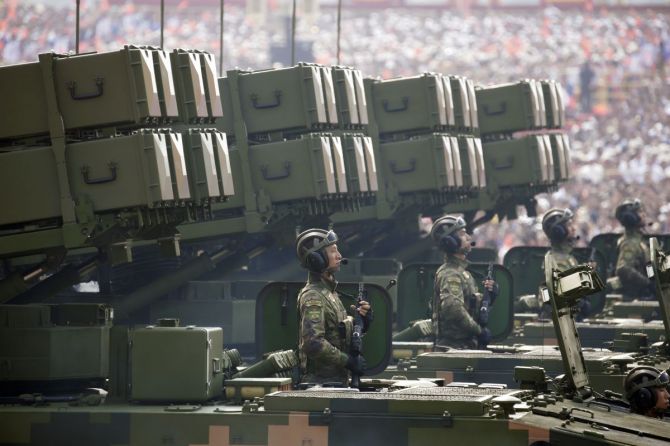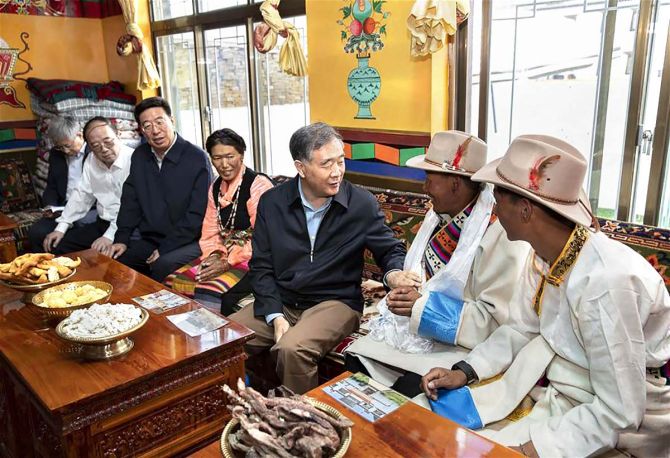The first priority for the new Tibetan administration in Dharamsala should be to look at Tibetan recruitment in the PLA, suggests Claude Arpi.

In recent weeks, news of the recruitment of Tibetan soldiers in the People's Liberation Army has been reported in the Indian media.
We had already written about this, in this column last year in July.
Last month The Hindustan Times went a step further; it asserted that a special unit composed of Tibetans was being raised by PLA: 'China's military has stepped up efforts to recruit more Tibetans amid the dragging border standoff with India on the Line of Actual Control, holding special recruitment drives across Tibet Autonomous Region since the beginning of the year.'
Quoting intelligence sources, The Hindustan Times further noted: 'PLA officials have criss-crossed the TAR to hold recruitment drives and to pick up Tibetan recruits who were already at PLA camps,' adding, citing intelligence reports and communications intercepts from three separate intelligence agencies:
"'here are also reports the PLA intends to create a Special Tibetan Army Unit. If this were to go ahead, this would be the first PLA formation comprising soldiers from a specific ethnicity,' The Hindustan Times added.
All this comes at a time when Penpa Tsering, the newly-elected president of the Central Tibetan Administration -- known as Sikyong -- is going to take over his job.
In an interview with The Week magazine, the Penpa Tsering stated that he planned to 'approach the Chinese government to facilitate a visit of the Dalai Lama to China'; he also hopes to 'bring Beijing to the negotiating table with the representative of the Dalai Lama for the resolution of the Sino-Tibetan conflict'.
When asked about his priorities, Tsering said: 'A key priority is the resolution of the Sino-Tibetan conflict.'
'Keeping in mind the international situation and the political dynamics, we will have to study the issue more closely and come out with the right strategy,' Penpa Tsering added.
'We also have to make good use of all the opportunities that come our way.'
It would extremely doubtful if the Chinese are in a mood to negotiate anything today with Dharamsala which should study the recent 11 rounds of talks between the Indian Army and the Chinese PLA in Ladakh; it will immediately be realised that even with muscles, tanks, artillery and 50,000 jawans, it is not easy (not to say nearly impossible) to make the Chinese bend.
Further, just look at the situation in Hong Kong, where the national people's congress in Beijing passed a new law ensuring that only 'patriots' can govern the former British colony; addressing the Chinese legislative body, Premier Li Keqiang showed that Beijing is serious about it, Li warned the world not to interfere.
According to the BBC: 'Critics say Beijing is crushing dissent and removing the 'one country, two systems' agreement it made with the UK.'
'Under the agreement, Hong Kong, a former British colony, was allowed to continue with its own legal system and have rights including free speech and freedom of the press.' It is all over now.
Chris Patten, the last governor of Hong Kong, observed that Beijing has 'taken the biggest step so far to obliterate Hong Kong's freedoms and aspirations for greater democracy under the rule of law.'

Could it be different for Tibet?
Nearby, in the Taiwan Strait, the situation has also greatly deteriorated during last few weeks.
According to Reuters, in March, in a day only, twenty Chinese military aircraft 'entered Taiwan's air defence identification zone, in the largest incursion yet reported by the island's defence ministry and marking a dramatic escalation of tension across the Taiwan Strait.'
The island's defence ministry announced the 'air force deployed missiles to 'monitor' the incursion into the southwestern part of its air defence identification zone. ....[Taiwans'] planes warned the Chinese aircraft, including by radio.'
The situation in the South China Sea is becoming tenser by the day, on April 23, Xi Jinping, China's supreme leader, launched three new warships in just one day from the Hainan Island.
China's People's Liberation Army Navy (PLAN) has acquired a new cruiser, an amphibious assault ship and A ballistic missile submarine. All using the latest technologies.
Popular Mechanics, a magazine reporting on science and technology, commented: 'The commission [of the three ships] reflected the breakneck pace of China's naval shipbuilding program, which has transformed the country's navy from a meager coastal defense force into the second most powerful navy in the world in just 30 years.'
No need to mention the treatment of the Uyghurs in Xinjiang and the propaganda orchestrated by Beijing for defending the indefensible.

In these circumstances, Dharamsala has little chance to succeed, especially after nine rounds of talks between Beijing and the Dalai Lama's representatives over nine years came to nil in 2010.
At the same time, the state of affairs in Eastern Ladakh is far from improving, on the contrary.
China is massing new weapons, radars, equipments and reinforcing the Xinjiang military district.
PLA divisions are also being reorganised, enlarged and modernised, introducing at a fast pace; the concept of combined armed brigades.
Moreover, land belonging to Tibetans living on the border are said to have been expropriated by the PLA to build new garrisons.
Xi's China is certainly in no mood to 'negotiate' with Dharamsala, especially when the 100th anniversary of the Communist party of China and the 70th of the so-called Liberation of Tibet are on the horizon.
Penpa Tsering will also have to be briefed about the intensive 'historical' education of the masses taking place in China and on the plateau.

Today all over China, the mood is Red.
On May 5, China Daily mentioned the Zhaojin Beiliang Red Army primary school in Shaanxi province: 'In 2018, the school was designated a demonstration school for Red education, which refers to Chinese revolutionary history, the spirit of role models and stories of the Communist party.'
In Lhasa, local leaders recently gathered at the 'Two Roads' Museum consecrated to the pioneers who invaded Tibet in 1951 and built the two roads (between Sichuan to Lhasa and Qinghai to Lhasa) between 1951 and 1954, which was indeed a remarkable engineering feat.
Today, Red slogans are flying all over; for example, Red Tourism should use 'Red Resources, Good Red Stories, carry out Red Education, inherit the Red Genes, cultivate core socialist values and keep the Spirit of Old Tibet, while remaining true to the Original Aspiration.'
Does it not sound like Mao Zedong's Cultural Revolution?
In these circumstances, 'negotiations' with the Tibertan government in exile in Dharamsala seem far away.
The priority should perhaps be to reconnect with the Tibetans inside Tibet, especially on the border areas.

In an article similar to the one in The Hindustan Times, the Indo-Asian News Service also spoke of the PLA recruiting 'exclusive military formations manned by ethnic Tibetans'.
Citing intelligence officials, the news agency said, 'Most of the recruits are mixed Tibetans -- mostly children of Tibetan mothers and Han Chinese fathers or otherwise.'
"Most of them are children of ex-PLA Han Chinese soldiers who got married to Tibetans."
'It is a fairly long process because the security vetting process after the initial selection on the basis of a tough physical and IQ test is very extensive,' an intelligence official monitoring the process told IANS.
In is undoubtedly a risky business for the PLA who 70 years after the 'Liberation of Tibet', still does not trust Tibetans enough to give them the command of a unit (or to become TAR party secretary).
Only a couple of Tibetan officers made it to the rank of major general in the PLA (namely, Major General Thinley, responsible of the recruitment of Tibetans and Major General Ngawang Dorjee).
It needs to be noted that hardly any Tibetans served in operational postings on the Indian borders, and no Tibetan has ever commanded the Tibet military district, a lieutenant general post (nor for that matter, a Uyghur, the Xinjiang military district).

Another serious development is taking place which Dharamsala should take notice of.
According to the Xinhua news agency, after retiring from the PLA, a number of Han soldiers who have served in the Tibet military district or the Xinjiang military district, 'took the initiative to sign up and chose the highest county in the Tso Nyi county of Nagchu City to make their contributions [to the motherland].'
'Over the past few years, after retiring, 17 retired non-commissioned officers "used their true qualities as soldiers and have moved to areas with an altitude of more than 5,000 metres, dedicating their youthful glory to write a new chapter in their life.'
The Chinese news agency cited several examples: 'Most of them are post-90s party members' (meaning in their thirties), have moved to settle in these remote districts 'to help [the Tibetans?] to get rid of poverty in high-altitude areas and take care of everyone.'
Xinhua continues: 'In 2017, Tibet recruited civil servants from PLA veterans across the country, and 17 people eventually came to work in Tso Nyi county.'
Tso Nyi ('the Two Lakes') ounty is located 'in the depths of the Northern Tibetan Plateau. It covers an area of nearly 120,000 square kilometres, has a population of only 14,000 people, and has an average elevation of more than 5,000 metres'.
'There are 10 months of long winter, with a minimum temperature of minus 40 degrees C.'
It is obvious that China plans to change the demography of these areas like never before.
It is true for this remote desolate place of Northern Tibet, but also for India's borders, whether north of Arunachal Pradesh, Sikkim, Uttarakhand or Himachal.
The first priority for the new Tibetan administration in Dharamsala (and the newly-elected assembly) should be to look into the issues of recruitment in the PLA and resettlement of Han 'veterans' on the plateau.
It may be less glamourous than to run to Washington to meet US state department officials, but it is the need of the hour.
Reconnecting with their countrymen in occupied Tibet is indeed the first task of the new Sikyiong and assembly.
Claude Arpi is a long-time contributor to Rediff.com.
Feature Presentation: Aslam Hunani/Rediff.com










